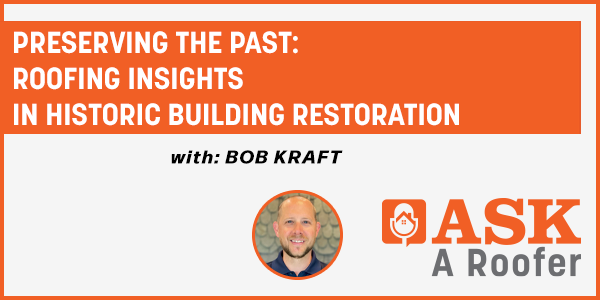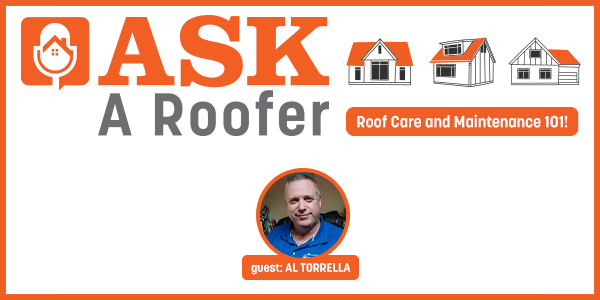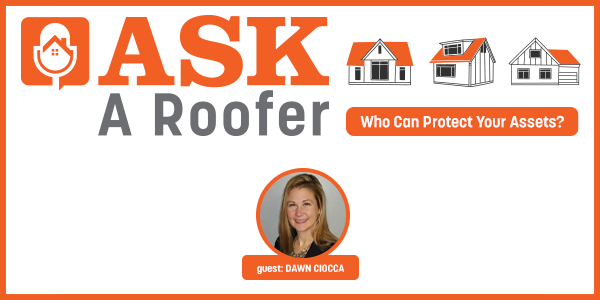Preserving the Past: Roofing Insights in Historic Building Restoration - PODCAST TRANSCRIPT
March 20, 2024 at 12:00 p.m.Editor's note: The following is the transcript of an live interview with Bob Kraft from Wagner Roofing. You can read the transcript below or listen to the podcast.
Megan Ellsworth: Welcome to the AskARoofer Podcast, where all your roofing questions find their answers. Your hosts, Megan Ellsworth and Lauren White peel back the layers of the roofing world to reveal the knowledge, tips and FAQs you've been curious about. From shingles, to skylights, metal, to asphalt, we are here to demystify the system above your head. So, get ready to ask, learn and explore the fascinating world of roofing one question at a time on the AskARoofer Podcast. Hello everyone. My name's Megan Ellsworth.
Lauren White: I'm Lauren White.
Megan Ellsworth: And this is the AskARoofer Podcast. Welcome back. Today, we're going to be talking about historic building restoration, and everything that goes into restoring historic roofs, and all that jazz. Super excited to have our guest on today. Bob, I couldn't read your name tag for a second. I was like [inaudible 00:00:58].
Bob Kraft: I got an easy name for you there Megan. Yep. Yeah.
Megan Ellsworth: Yeah. Wow. Easy name Bob. Same going backwards as it is forwards.
Bob Kraft: It was real easy spelling as I was growing up. Yes. Yeah.
Megan Ellsworth: Well, Bob, Wagner Roofing. Hello, how are you?
Bob Kraft: Good. Thanks for having me on. This is exciting. This is actually my first podcast. So this is-
Megan Ellsworth: Oh my God.
Lauren White: Yay.
Bob Kraft: ... checking it off the bucket list here. Yeah.
Megan Ellsworth: Yay. Well welcome. Congrats.
Bob Kraft: Yeah. Thank you guys for having me.
Megan Ellsworth: Absolutely. So, let's just have you introduce yourself-
Bob Kraft: Sure.
Megan Ellsworth: ... and tell us a little bit about Wagner Roofing.
Bob Kraft: Sure. I'd love to. So Megan, as you said, my name is Bob Kraft. I'm a project executive here at Wagner Roofing. We are in Hyattsville, Maryland, which is just outside of Washington, D.C. Wagner Roofing has been around. We're actually in our 110th year this year.
Megan Ellsworth: Whoa.
Bob Kraft: Yeah. Yeah. Pretty crazy.
Megan Ellsworth: That's wild.
Bob Kraft: Yeah. Yeah. Started, there was three generations of Wagners before [inaudible 00:02:12] Dean Jagusch actually took over the company back in 2016. So yeah. Been around a long time in the area. Got a pretty good footprint, really good reputation, especially in the topic that we're going to be talking about today. But yeah. So we, again, 100 plus year company. We specialize in historic restoration, what we're known for in the area. That's steep slope slate, copper, wood shake, tile, custom, copper ornamental, sheet metal, cornices, gutters, stuff like that.
We do plenty of install new material, new out of the ground projects as well, a little slope [inaudible 00:02:59], private or residential. We do ton of residential around the area as well. And then we also have a full service department too that can handle a mix of the both, whether it's the low slope, or steep slope stuff. But we serve the DMV, which is what it's called around here. So we serve Maryland, obviously D.C., Northern Virginia. We can travel up into PA Delaware, and depending on the project, we also can travel elsewhere in the country. But our main, our backyard here is Maryland, D.C. and Northern.
Lauren White: Wow.
Megan Ellsworth: Wow.
Lauren White: Yeah.
Bob Kraft: Yeah.
Lauren White: Lots of history there, and lots of historical homes and buildings there too.
Bob Kraft: There is, yeah. Which is exciting to talk about. Yeah, because been on a number of iconic buildings that you guys probably learned about when we were growing up in school. And it's really fun now to actually get to work on some of them. It's pretty crazy to see some of these iconic buildings, especially right down here in D.C. But in terms of historical restoration, definitely a great market to be in for sure.
Lauren White: Yeah. Very cool.
Megan Ellsworth: So, I guess just diving right in, if someone is living in a historic home, or is in a historic building, what should they be looking for on their roof for if they need it to be restored? What does that look like?
Bob Kraft: Yeah. A great question too, because obviously, if I'm thinking of them myself, and I'm just Johnny Homeowner, and I haven't been in the roofing business, what do you do? What questions do you ask? I don't even think I would've known that maybe I would have to go back with something that is maybe historic in nature. So, I think some of the things that we try to do is educate, and I know we'll get into that a little bit later, but is try to educate them, particularly in maybe the neighborhood, the municipality or jurisdiction, every one of those is going to have a different maybe requirement to what you have to do to go back with. There's different trusts that are involved that they can come in, and decide on what you have to do. So it is important, at least even with on the residential homeowner side, is to try to give them that information.
Luckily, we've been working in the area for a long time. So we know what to expect. If you're down on Capitol Hill, or you're in Georgetown, you're in this neighborhood, all of those different jurisdictions are going to have different requirements for what you need to go back with your roofing material. So that's probably step one is trying to educate them, "Hey. Look, we've done a few of your homes in this area of the past. This is what we've seen," and try to walk them down line, because again, I don't think had I not been in the roofing business that it would be anything that we didn't think about. You know what I mean? So I think that's step one is definitely making sure that if you do have to replace the roof, you're going to meet requirements that are necessary depending on where you live. So I think that would be step one. Yeah.
Megan Ellsworth: Yeah. Wow. Yeah. There's so much that goes into any roof, let alone a historic roof. So it's always good to get your nuts and bolts together.
Bob Kraft: Yeah. Yeah. Because again, there's a lot of requirements of matching the historic nature of what was there. So making sure we get that right is definitely part of the conversation as we are even in the estimating process of the project itself.
Megan Ellsworth: Going off of that now, what are some unique challenges that arise when you're restoring the roofs of historic buildings?
Bob Kraft: Sure. Yeah. Great question. So first and foremost I would say is having that skilled workforce that can be able to perform that type of work, because it's not every day that you have skilled sheet metal workers just walking down the street. Luckily, we have a lot of guys that work for us, and have been around for a while, but we understand that there are other roofing companies that wouldn't be able to do that. There's things that we can't do either. There's definitely a market for that stuff, but having the right people in your office that actually could perform that work is step one. Right? But it is a unique challenge in terms of actually finding or teaching. It could take years to actually teach somebody coming up through the company to actually be able to perform some of the things that are necessary on a historic roof.
So the other thing that is challenging is a lot of these roofs are 100 plus year, but they're also 100 plus year-old building. So over the years, building starts to decay. You got unforeseen conditions. When you go and rip off the roof, you never really know what you're going to find back there in terms of substrate, or I'm sure you guys, whether it's lead paint, some of the asbestos, stuff like that, that's always got to be something that's on your radar when you're dealing with stuff like that, because it might not be very obvious on the outside looking in when you're pricing it. So yeah. Again, you never know what you're going to find when you start ripping the roof off, and being prepared for that. Luckily, we've been doing it a long time and we already planned to look for that stuff.
We're not caught off guard when something like that happens. And again, what I was mentioning too is these buildings over the years obviously can start to shift a little bit, move and when it comes to actually putting back ornamental cornice, metal, even slate or whatever, that can be a tricky thing, because you might get a set of plans that everything is very nice and straight, and the reality is it's not. And you got to be able to adapt to some of that. And luckily, we're able to do that fairly easily, because we have a full sheet metal shop here that can change some of the profiles, or taper down depending on what that building substrate looks like. But it definitely can be a challenge working on old buildings. But again, we've been doing it for a long time. So it's something that we're accustomed to.
Lauren White: Yeah. For sure. Mm-hmm. And going off of that too, and working on these historic structures, are there any specific regulations or guidelines that contractors need to adhere to, and should home and building owners be aware of these regulations as well?
Bob Kraft: Yeah, Lauren, great question. Absolutely there are, and it's a little bit different when you're working on the residential side versus the commercial side, but what I mentioned earlier is each one of these little neighborhoods, or jurisdictions, even states, I'm obviously thinking about what we do here in the D.C. area, but they're all going to have different regulations and requirements as to what you need to do, or what you need to follow in terms of putting things back, matching material, matching profiles. So reaching out to whether it's the district, any HOA requirements, getting approvals from, like I said, historic societies, or trusts, even coming out, letting them know, "Hey. This is what I'm about to do. Is there any," asking the questions upfront, so you don't get trouble on the back end when you're actually going to do the roof.
So yeah. There could be certain permitting aspects to it that you got to be aware of, but again, I think every jurisdiction, state, it might be a little bit different. So I think it's just asking those questions upfront. If anything, you're going to get provided information, and you know exactly what you need to do to be able to go back to check that box on the historic side of things.
Lauren White: Makes sense.
Megan Ellsworth: It's crazy to me to think that some of the materials you're replacing with the historic homes are probably upwards of 100 years old. That's wild. So how do you meet the balance between preserving those original materials, and then if something needs to be replaced, replacing them with newer, more durable options?
Bob Kraft: Megan, great question. Another great. You guys are coming with some great questions here. Yeah. High-hitting questions here. Hard-hitting questions. Yeah. You know what? It is tough, because even on some of the buildings that we work on, look, some of the material's no longer really available. Some of the tin, some of the slate even that we replaced. So I think it could be twofold. We can go in there. Obviously we're going to recognize what type of material they have, and we're obviously going to try to go back with and match it with new material if we can. If we can, if the material is in good enough shape where we can just salvage it, we might go in there and actually remove whether slate, copper, whatever, come in, and put a newer, an underlayment or stuff that's obviously been around just over the last 30 years, newer material that can help preserve the guts of the roof, if you will.
And then we can go back on with the dressing, if you will. Now, that's not always an option, just because maybe the material is just beyond its lifespan. So it is tough. We're always going to try to, I won't say push, but we obviously love the real slate. We love copper, but there's obviously cheaper materials around, and it does maybe sometimes come down to a cost thing. Now again, there's some parts of the city where they're going to say, "No. No. You have to go back with real slate. You can't use synthetic slate. You have to go back with copper in lieu of maybe a painted aluminum or something." So we're always going to be cognizant of that. But in terms of a homeowner, it could come down to cost sometimes, which, and we're accustomed to having those conversations too. It's one of those. We're going to sit here, and say, "You still got 100-year roof with slate."
"You can get 100 years out of copper." You're obviously going to pay for that up front, but which is expensive, and I completely understand that. So if it's a cost issue, there are definitely newer materials as you mentioned, that we can certainly suggest. But we do got to be a little bit careful on the historic side of things, making sure that we check those boxes. So a little bit of a give-and-take there. Again, we would love to go back with copper, and slate, and wood shake, and match what was there, but it's just not always the case sometimes.
Megan Ellsworth: Mm-hmm. Sure. Do you ever use manufacturers that create a composite roofing, but it looks like slate, or it looks like shake?
Bob Kraft: So, I'll tell you what. We have in the past. Again, they got synthetic slates. They got maybe synthetic shingles, or whatever. We've done in the past in certain circumstances. Again, not our bread and butter, but the material's definitely out there.
Megan Ellsworth: Okay.
Bob Kraft: I don't know that you'd be able to check that box with some of those historic registries, but it's something that I think, "What's the worst that can happen is if you propose it, and see what they say?" Again, I think they're really more focused on aesthetics more than maybe actually the actual material itself. So if you can get close to what it look like, it's something that's going to be long-lasting, then you may have a shot into going to get a newer material, like you said, like a composite, or something approved.
Megan Ellsworth: Cool.
Bob Kraft: Yeah. Great question. Yeah.
Lauren White: So, what does the research and documentation process look like for these restoration projects, especially regarding that historical accuracy like you were just touching on?
Bob Kraft: Yeah. That can be a tough thing, right? Especially, you could go down into D.C., and go to a row home, that we know it's historic. We got a [inaudible 00:16:34] was there 100 years ago, but the cornice, or the mansard's not even there. What do you do? Right? You don't have anything to go off of. Luckily, and we've done this in the past, but typically when these buildings, or these homes were built, they were typically built a number of them at the same time. So sometimes you get lucky if you just go down a couple streets over, you could see maybe somebody that actually took care of it a little bit better or maintained it to give us an idea of maybe what that looked like, what was the profile. We've done that in the past. Another way to do that is actually getting out of the building itself, and being able to take off a piece of metal, or a piece of slate, bring it back to the shop.
So we have exactly the measurements, the shape, profile that we can replicate here in the shop. And then the other thing is if for some reason you can't check those two boxes, luckily, with the historic properties that we work on, typically, you're going to be able to even go online, look up photos when it was originally constructed or at least get something close that you know that you can be able to match, and go back to try to get it back to what it originally look like. So a couple of different options. It's easier said than done, but there's definitely ways to do it.
Megan Ellsworth: Very cool. [inaudible 00:17:59]. So what are some trends or advancements in the historic building restoration sector that you've been seeing more of as of late?
Bob Kraft: Okay. Yeah. I mentioned it earlier, but obviously I would think maybe the parts of the roof system, maybe beneath what you would see has obviously advanced with some of the underlayments and stuff like that over the years are obviously way better than the felt paper and stuff that they were accustomed to years, and years, and years ago. A lot of maybe the equipment and machinery that's available, we have a CNC router that we use to cut out some of our [inaudible 00:18:49]. So now you're using computers to get super, super accurate measurements and cuts. So I would say the advancement of actually making the material has come a long way. When it comes to installing it though, we're still going back to the same hammer and nail approach when you're soldering, and stuff like that. But I would think there's definitely, in terms of making the material, I think we've come a long way for sure. Yep.
Megan Ellsworth: Cool.
Lauren White: Awesome.
Bob Kraft: Yeah.
Lauren White: So, with any roof, there are insurance considerations, and risk management strategies, but what does that look like for historic building restoration projects? Is there anything specific or unique to those insurance considerations, or risk management strategies?
Bob Kraft: Yeah. That's a tough question. I don't know that we have any special type of insurance to cover the historic side of things, but I think it's tough on the historic side of things with some of the materials, whereas in the low slope, single ply world, you're going to get these manufacturer warranties, and 50 year, 50 plus year warranties that are all-encompassing on the system itself. On the historic side, you're going to get a material warranty, but you're backed by a workmanship warranty by whoever installs it, which I think maybe 10 years is going to be probably maybe the highest workmanship warranty you're going to get. Typically, we're anywhere between the 2 and 5 year. So that is a tough thing to not have to deal with, but just be aware of when it comes to, on the historic side of things, because again, I think insurances, and warranties, stuff like that, it's definitely different from than what you're dealing with on the low, slope, flat side of things.
But again, they're going to stand behind their material, and if you can work with a contractor like ourselves that are well-respected, have been doing it a long time, I think that trust goes a long way into ensuring that we're installing the roof the way it's intended, and it's going to last 75 to 100 years.
Megan Ellsworth: Yeah. Yeah. It's crazy that those historic homes, the roofs on historic homes, they last so long. That's wild.
Bob Kraft: Yeah. Again, I think I know it is awesome. And that's why I really love working here too, is every project we work with is unique, and there's a true art of being able to replicate-
Megan Ellsworth: For sure.
Bob Kraft: ... some of the historic elements on these buildings. And it's cool to work on the buildings, and then to know that when you're done, we could stand behind it and know that that's going to, again, it's going to last 75, 100 years. That's pretty wild to think about. It's certainly going to outlast me at least.
Megan Ellsworth: Yeah.
Bob Kraft: Yeah. But it's pretty neat. Yeah.
Megan Ellsworth: That's cool.
Bob Kraft: And it's definitely gratifying work too.
Megan Ellsworth: Yeah. That's awesome. So our listeners are all home or building owners. So when you have a client, and they own a culturally significant structure, or a landmark, or historic home, what are some ways that you educate them to help them know the restoration process a little bit better for their home?
Bob Kraft: Yeah. Yeah. Good question. Again, I hate to keep beating it into the ground here, but I think it's just super important to know what the requirements are, depending on what neighborhood you live in, jurisdiction, municipality, again, I think they're all going to be a little bit different. But again, being able have the conversations with them up front, and giving them the information like, "Hey. These are the steps that you're going to have to take to be able to modify your roof, or replace it, or," it's hard to just say there's this one thing that you can do, and it'll be the same across the board. It's all going to depend on again where you live. And obviously I know what we do with here in D.C., but I think that's probably across the board, different states, cities, whatever, counties. I think educating them on that part of it would obviously be the first step, and then you can obviously help them along the way as they start that journey.
Lauren White: For sure. Absolutely. So here's a fun one. What has one of your favorite projects been that you worked on?
Bob Kraft: Good question, Lauren. I'll tell you what. It's cool because it's fresh in my mind, but I just wrapped up working over at the U.S. Capitol Building.
Megan Ellsworth: Oh.
Lauren White: Wow.
Bob Kraft: Yeah. Right?
Megan Ellsworth: Okay. Slay.
Bob Kraft: Yeah. So I think you guys can picture the dome in your head, right? Very iconic building for all Americans. Yeah. But we did a project out there last year. We did a water table replacement about 600 feet. There was some liquid membrane aspect to it as well, but pretty cool when again, that building's so iconic. But then being able to be on scaffolding, being able to touch the building and being right next to it, and look over, see the Washington Monument, the Reflection Pond and all that stuff, it was pretty wild. I found myself pinched myself going, "Man, this is crazy." Being from Ohio, we used to, I don't know if you guys did this too, but we would take an eighth grade trip to D.C. Was this the thing for you guys too? Okay.
Megan Ellsworth: Yep.
Bob Kraft: Yeah. And if I could tell my eighth grade itself, because obviously you're going all the monuments, learning about that, "Hey. You're going to be replacing a part of the roof up there one day," I think I would be pretty shocked, but that one certainly freshened my mind. We've been on a ton of the historic buildings down here, which just very fortunate to live in the area and be able to work in and around D.C. It just we're very fortunate to have the opportunity to be able to work on such awesome structures and buildings. That one's definitely up there Lauren. That one's pretty close to the top.
Megan Ellsworth: Wow.
Lauren White: That's amazing. Well, I'll be there in April. So I'll get to see your handiwork for Roofing Day.
Bob Kraft: Are you going to Roofing Day? Cool.
Lauren White: I am.
Bob Kraft: I'll be down there. So we [inaudible 00:26:17].
Lauren White: Awesome. Oh. All right.
Bob Kraft: Yeah. Come on down.
Lauren White: That's awesome.
Bob Kraft: I can go point out at least exactly what we did.
Lauren White: So cool. Definitely.
Megan Ellsworth: I love that.
Bob Kraft: Yeah.
Megan Ellsworth: Wow. Well, we're talking to a celebrity. That is so cool.
Bob Kraft: I don't know about that Megan. I don't know about that, but ...
Megan Ellsworth: Well, congratulations. That's really cool. That's an awesome job.
Bob Kraft: Yeah. Thank you so much. Really appreciate it. Yeah.
Megan Ellsworth: Yeah. Thank you so much for coming onto the podcast. Any last words or pieces of advice for anyone that owns a historic home, and they need their roof replaced?
Bob Kraft: Yeah. No. Well, first of all, thank you guys so much for letting me come on again. I've been able to check that off my bucket list, which is awesome. But yeah. Again, I think just do your homework, right? Ask a lot of questions first. I think there's probably a lot of people out there that don't do that, and they think they could just go, and replace the roof, and unfortunately, it is just not as easy as that. Obviously, you want to procure the historic aspect, appearance of what you have there. It's super important. And again, yeah. Ask questions. Do your homework within whatever municipality that you live in I think is going to be a great start. And if you're in the area, in the D.C. area, and you need a trusted roofer, give me a call, Wagner Roofing, Bob Kraft, and we'll come out, and take a look.
Megan Ellsworth: Yeah.
Lauren White: Awesome.
Megan Ellsworth: Everyone listening, you can find all of the Wagner Roofing info and contact info in the AskARoofer directory, and RoofersCoffeeShop directory. So everyone go check them out. And if you're in that area, hire them. What are you doing? Awesome, Bob. We loved having you. Thank you so much.
Lauren White: It's fun.
Bob Kraft: Megan and Lauren yeah. This was great. I'd be glad to do it again. So keep me in mind.
Megan Ellsworth: Awesome.
Bob Kraft: And Laura, I'll see you in a few months for Roofing Day.
Lauren White: I know. Very exciting.
Megan Ellsworth: Amazing. Everyone out there., Stay tuned. Make sure you subscribe, and you're following us on all the social medias, and ring the bell so you get notified every time we post a new podcast episode. And stay tuned for the minisodes that are going to be coming out shortly. And this has been the AskARoofer Podcast.
Lauren White: So, we just chatted with Bob Kraft from Wagner Roofing to talk about-
Megan Ellsworth: Bob.
Lauren White: You know what I know to talk about? Historic restorations on buildings, and it was fascinating. We read about project profiles, and we write about project profiles on these historic buildings, but to actually talk to somebody who's been on some of those, super interesting, all the things you don't think about.
Megan Ellsworth: Yeah. No, all the things you don't think about. And he worked on the freaking US Capitol building-
Lauren White: I know.
Megan Ellsworth: ... the really famous one.
Lauren White: Right. Yeah. That we all have learned about-
Megan Ellsworth: That's crazy.
Lauren White: ... and some people have been able to visit. I was able to visit in eighth grade. I think Megan you did too.
Megan Ellsworth: I actually didn't, but I went when we lived on the East Coast. I saw it then. Yeah. When I was little.
Lauren White: Yeah.
Megan Ellsworth: So cool. I know.
Lauren White: Pretty incredible. He said he had-
Megan Ellsworth: So cool.
Lauren White: ... to pinch himself to be like, "Is this real life?"
Megan Ellsworth: I know.
Lauren White: He's touching it like, "Oh my God."
Megan Ellsworth: I know.
Lauren White: "This is really old."
Megan Ellsworth: And it's crazy. We talked about its wild that people are living in these 100s of years old houses, or work in these really old office buildings that are 100s of years old, and then all of a sudden, maybe you have a roof leak, and you're like, "Frick. Who do I call?" It's not Ghostbusters", or maybe it is if you're in a 200-year-old building. And then they have to figure out, "Can we repurpose some of these original materials that we have to tear off, right? Can we find a replacement that looks similar enough?" That's crazy that they have to work inside these confines.
Lauren White: Right. And things have changed in the last 100, 200 years of how we roof, and the materials used. And I thought it was interesting even a newer product that might resemble a shake, a wood shake, but be made of a different material that's maybe built to last longer, because of that historical nature, they might not be able to use that maybe newer, more durable material, because it then wouldn't check the box for it to remain a historical building, or a historical home, which I thought was really interesting.
Megan Ellsworth: Mm-hmm. It's also interesting to think that these roofs have lasted so long, and they're not made of these new age materials. It's literally just rock, slate or cedar shake, or copper piping and metal, and stuff. So that's crazy. It shows me sometimes the original is the best, but also sometimes not.
Lauren White: Exactly. Yeah. It depends on the building, and the location too, where you live and what elements everything is exposed to. But I thought too was interesting they have to research what this house or building looked like ahead of time, and it deteriorated a little bit over the years. But if it looks slightly different, he was saying they can just walk around the neighborhood, and take a look at other roofs that are historical as well in the area, or the row homes. They're on the East Coast, and that's how they do their research, and see maybe a different roof that had more maintenance, or more regular upkeep, or something like that. And then they can get their project details from that roof to then apply it to their project at hand, which was, I never thought of that.
Megan Ellsworth: Yeah. And it's also crazy that your house can have a little twin down the street, because just how they built houses back then. And, in a lot of neighborhoods now too, in the suburbs, a lot of the houses look similar, but the fact that their research is on the ground, not in the computer.
Lauren White: Right. Yeah.
Megan Ellsworth: And then also he mentioned when if they do have to tear off, they don't always know what's going to be underneath, which is scary, lead paint, asbestos, mold. And then you have to think, "How can you as a homeowner be prepared for those situations, and make sure all of your things are covered, and safe, and you're providing space for the workers so they can have the appropriate PPE, and can feel safe with removing those materials and stuff?"
Lauren White: Yeah. Right. You'd never know what you're going to find with a lot of construction projects.
Megan Ellsworth: We used crazy stuff back then. Yeah.
Lauren White: Yeah. You can open that to other things, but yeah. So a lot of Bob was saying a lot of what they do is having to pivot too, and when you uncover something new, and you might have to go change your plan a little bit.
Megan Ellsworth: Yeah.
Lauren White: Very frank conversation.
Megan Ellsworth: Thanks Bob, for chatting with us.
Lauren White: I know. I know. And so fun-
Megan Ellsworth: He was great.
Lauren White: ... all the projects that they've been able to work on.
Megan Ellsworth: Yeah. Yeah. And he said the Capitol Building wasn't his only, because they've been doing this for 100 years. Also, they're historic ...
Lauren White: Seriously.
Megan Ellsworth: ... themselves.
Lauren White: I know. 110 years?
Megan Ellsworth: Yeah.
Lauren White: It's amazing. Yeah.
Megan Ellsworth: That's crazy.
Lauren White: Yeah. And so many historical buildings on everywhere, but especially the East Coast, and yeah. So pretty amazing opportunity.
Megan Ellsworth: Yeah. If I was a roofer, I would think I would want to be a historic restoration roofer.
Lauren White: And [inaudible 00:34:52] yeah. For sure.
Megan Ellsworth: That's a good question for all you homeowners out there, if you could be a roofer, what roofer would you be? Let us know in the comments.
Lauren White: Yeah.
Megan Ellsworth: I'm curious now.
Lauren White: Another great episode in the bucket. I'm looking forward to our next one.
Megan Ellsworth: Awesome. We'll see you on the next one. If your roof needs answers, subscribe now to the AskARoofer Podcast. We've got your questions covered, one episode at a time. Go to askaroofer.com to submit your questions, and learn more. Stay tuned and keep those questions coming.














Comments
Leave a Reply
Have an account? Login to leave a comment!
Sign In